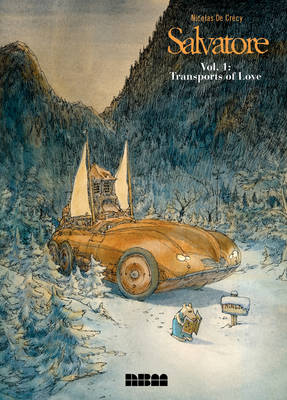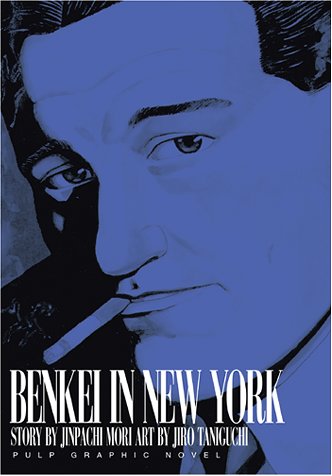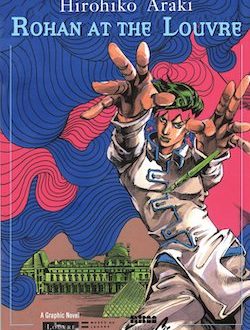It doesn’t take a village to write a review, but darned if it isn’t more fun when you tackle a challenging book with a neighbor. That’s exactly what David Welsh and I did this month: we both read Nicolas de Crécy’s latest work, Salvatore, then spent a couple of weeks comparing notes on the book. The results are less a formal critique than an animated and open-ended conversation. We hope you’ll keep the discussion going with your own thoughts about this odd, fascinating story.
 David: To start, I thought I’d describe my admittedly limited background with Nicolas de Crécy’s work. The first time I encountered him was in Fanfare/Ponent Mon’s anthology, Japan as Viewed by 17 Creators. He contributed a piece called “The New Gods” which is about commercial design and the prevalence of cartoon mascots in Japanese culture, and it’s a neat, uneasy little piece. The only other work of his that I’ve read is Glacial Period, created in conjunction with the Louvre to celebrate that great museum and published in English by NBM, also the publishers of Salvatore. Glacial Period is about a group of archeologists who use these hybrid dog-pigs to sniff out history. It’s whimsical and smart and a little on the creepy side. Salvatore has a number of narrative threads working through it, including a dog who’s an auto mechanic and is trying to reunite with his childhood love, a myopic sow who’s lost one of her enormous litter of piglets, and a goth cat who can’t seem to offend her liberal parents.
David: To start, I thought I’d describe my admittedly limited background with Nicolas de Crécy’s work. The first time I encountered him was in Fanfare/Ponent Mon’s anthology, Japan as Viewed by 17 Creators. He contributed a piece called “The New Gods” which is about commercial design and the prevalence of cartoon mascots in Japanese culture, and it’s a neat, uneasy little piece. The only other work of his that I’ve read is Glacial Period, created in conjunction with the Louvre to celebrate that great museum and published in English by NBM, also the publishers of Salvatore. Glacial Period is about a group of archeologists who use these hybrid dog-pigs to sniff out history. It’s whimsical and smart and a little on the creepy side. Salvatore has a number of narrative threads working through it, including a dog who’s an auto mechanic and is trying to reunite with his childhood love, a myopic sow who’s lost one of her enormous litter of piglets, and a goth cat who can’t seem to offend her liberal parents.
I think my strongest impression of Salvatore is that it makes me a little anxious, which isn’t necessarily a bad thing. Most of Joann Sfar’s work – Klezmer, The Rabbi’s Cat, Vampire Loves – and Taiyo Matsumoto’s comics – TekkonKinkreet and Gogo Monster – also have that effect. I suspect the anxiety partly comes from how visually dense de Crécy’s comics tend to be, sort of dragging your eye in a bunch of different directions at once, and how morally vague his characters and their situations are. What’s your initial, ink-blot response to Salvatore and to de Crécy in general?
Kate: I’m glad you used the word “anxious” to describe your reaction to de Crécy’s work, as I also find his stories unsettling. Some of it I attribute to his animal protagonists; they’re not the least bit disarming, but endowed with the kind of flaws, eccentricities, and inconsistencies that we associate with literary realism. Usually authors endow their animal characters with human traits in an effort to close the species gap, to suggest parallels between human and animal behavior, but in de Crécy’s work, the effect is very different: his animals seem less like walking metaphors and more like individuals. The animals’ physical appearance, too, is unsettling; no one will ever accuse de Crécy of pandering to the Daily Squee crowd. I found the sow in Salvatore, for example, a vaguely grotesque figure, with her squinty eyes and parasitic brood of piglets, while Salvatore himself looks more like a pig or a hamster than a dog.
I also find de Crécy’s artwork a little unsettling. Like you, David, I admire the clarity of his vision, and his incredible attention to detail, yet I find de Crécy’s linework pulses with a strange energy; it’s as if a nervous little dog were drawing the images. Almost every adjective I could come up with to describe the lines sounds very unflattering (e.g. “spidery,” “shaky”), but I actually find de Crécy’s work quite beautiful in its idiosyncracies.
David: His style is very organic in exactly the way you describe which, for me, is an unusual use of the word. In this case, it’s more that the illustrations have a slightly arhythmic, unsettling pulse, which means that things can feel both very stylized and very “real” at the same time. I’m thinking in particular of the sow, as you mentioned, with her unnerving squint and rolls of flesh. Another example might be the cow who crops up later in the narrative, who is both menacing and unpleasant in the ways an entirely human character might be but also in ways that are sort of bovine-specific. It’s a kind of anthropomorphism that’s both restrained in terms of the rules the artist sets for himself, but it’s also demonstrative of a very creepy, unhampered imagination.
de Crécy seems very, very aware of the imposition of bits of human culture that he’s superimposed on what might be called animal culture. A sow can take her car to get repaired, but a pig can still wind up in the butcher’s window, you know? Those contradictions don’t seem entirely offhanded to me, but I’m darned if I can pinpoint exactly what de Crécy’s formula is. That might be another source of anxiety for me as a reader.
Kate: That’s a good point: I’m not sure if de Crécy is aiming for magical realism or something else. There’s plenty of whimsy and imagination in Salvatore, but it’s tempered with a very frank sensibility. Tonally, it sits somewhere between the kind of fantasy where talking animals signify the supernatural and the kind of satire in which animals are used to make human behavior look absurd or cruel.
In light of our conversation, I’m wondering what you thought of Salvatore himself: could he have been a cat or a raccoon? Or is his dog-ness somehow fundamental to the story?
David: That’s a question that goes to one of the sources of interesting tension in the book for me. I have a dog, and I love dogs, and Salvatore doesn’t have many of the core qualities that I would ascribe to that species, which would be loyalty and a desire for companionship, a pack. But the animal characters generally don’t line up entirely with traditional perceptions of their species, except maybe for the cat, who’s kind of capricious and contrary. (At the same time, she’s also the animal character who looks most human to me, a girl in a cat suit rather than an animal that just behaves in human ways.)
On one hand, I think that Salvatore could have been any creature with the same essential nature — secretive, determined, somewhat amoral. But I do wonder if the creator wasn’t trying to create a tension between what we expect of dogs and the kind of character he wanted to write. Salvatore is a dog because he doesn’t act like one. If anything, his poor little human companion is more like a dog to me than Salvatore. It’s like the Grinch and Max switched bodies.
Kate: Exactly! I thought the scene in which Salvatore debated whether to leave his human companion behind was surprisingly effective, touching on all the emotions that dog owners experience when they’re worried about subjecting a pet to physical or emotional discomfort. In switching the dog-human roles, though, de Crécy lays bare the essence of that dog-human compact; there are no pleading eyes or whimpers to prompt us into feeling sorry for Salvatore’s pet, just Salvatore’s deep concern for his welfare.
What did you think of the supporting characters (e.g. the raging bull couple, the cat girl)? Did you find them as persuasive as Salvatore? And what about the numerous subplots introduced in the second half of the book: do they feel essential to moving the story along, or do they register more as tangents?
David: I found them persuasive as characters, but I felt that their animal identities were much less of a factor in their persuasiveness or their interest than they were with Salvatore. It seemed as though de de Crécy may have spent all of his energy creating that anti-dog dissonance and had that be the fulcrum of what we think of as animals acting against what we think of as their natures.
Basically, that leaves me to evaluate the rest of the characters just as characters, so my reactions are mixed. I liked the cows because they’re so awful and shallow. They were refreshing, because I didn’t really experience any ambivalence when reading about them. The cat was less successful, because she feels so cliché to me. Brief as those scenes were, they dragged for me.
On the whole, I appreciate the attempt to expand the narrative. It’s a tricky thing to attempt, creating these antic, concurrent threads that still all have a sadness to them, and trying to make them all hold together into a single, dark farce. I don’t know if the attempt is entirely successful yet. What did you think of those sequences?
Kate: For me, the most successful subplot involved the sow bonding with her piglets. She’s an awful mom at first: distracted, foolish, and disconnected from her babies. But then she begins to see her husband’s face in her litter, and the tenor of their relationship changes. She’s more affectionate and more solicitous of her piglets’ needs, even though she misses her partner and feels overwhelmed by the sheer size of her new family. I thought that was a lovely and subtle development in a storyline that initially repelled me.
As for the other subplots, I have to agree that the business with the cat-girl was the least dramatically persuasive, in large part because it seemed so random. But not in a “hey, life can be arbitrary” sort of way, but in a contrived, French arthouse movie sort of way; those scenes felt like something from an early draft of the Amelie screenplay. The cows were a more successful addition to the story; they were believably cosmopolitan and crass, the kind of folks you might find in sitting in a cafe in Paris or New York, conducting their personal business in public.
David: Yes, the pig’s story is definitely the most resonant of the subplots, to the point that I’d almost call it a co-plot. I like the way you describe her evolution, and it just about makes me change my mind on my earlier position regarding the amount of conceptualization the author did with various animal archetypes. She starts out very barnyard, very domesticated in assuming that her needs will be met without much thought or effort, but as her arc progresses, she becomes more conscious of survival. She’s not quite feral, but she’s certainly more active in achieving her desired ends.
In fact, I’d say it’s for her story as much as Salvatore’s that I’ll stick with this fascinating but slightly vexing series. What about you? In for the haul?
Kate: I’m on the fence about Salvatore, in part because I find it a little over-scripted; de Crécy has a very strong urge to narrate, even though he’s a terrific visual storyteller. The scene in which the sow catapults down the snowy mountain, lands on top of a plane, then sails back down to Earth is just the sort of wordless (or largely wordless) sequence that I wish de Crécy did more of; it’s a gorgeous bit of visual choreography that nicely underscores what a space cadet Amandine really is.
I also feel ambivalent about Salvatore’s predicament; it’s so ridiculously French that I hear accordions every time he looks sorrowfully at Julie’s picture. But the pig’s story has grown on me, and the cows amuse me, so I’ll give Salvatore one more volume before I throw in the towel.
David: So we both come down to a ruling of “ambivalent but still engaged.” Shall we resume this conversation when the second volume arrives to alternately charm, confound and distress us?
Kate: It’s a date!
SALVATORE, VOL. 1: TRANSPORTS OF LOVE • BY NICOLAS DE CRÉCY • NBM/COMICSLIT • 104 pp.




Jade Harris says:
This was a fun read, but I got confused between the bibliographical info and the summary of Salvatore in the same paragraph. That stuff may have worked better in a preface outside of the commentary too, I think it gave David’s serve a bit too much authority in the initial banter.
Katherine Dacey says:
That’s my fault, Jade: I worried that some readers wouldn’t be familiar with the book, so I included the publisher’s blurb about the book in the intro. It is a little redundant, given David’s opening statement, but I figured it might encourage more people to familiarize themselves with Salvatore.
Thanks for the feedback!
Jade Harris says:
I do prefer David’s run-down to the blurb. I just think it gives his voice a little too much weight in both wordiness and information. It creates an illusion of your not finding your footing in conversation with him for a while. If that first paragraph were pulled from his actual opening statement and put somewhere else, I think that would have worked better to put you both at an equal standing in the conversation.
Melinda and Michelle can get away seeming like they’re informing each other about titles because they often are and they go back and forth.
Katherine Dacey says:
Obviously that wasn’t the case here; David and I had both read the book. We have a different style of discussing a book than Melinda and Michelle do, and if doesn’t work for you, I understand.
David Welsh says:
Oh, geez, I don’t sound like I’m mansplaining or fansplaining, do I? I live in fear of coming across like that.
Katherine Dacey says:
Never! I think Jade’s point was that messed with the flow by padding the introduction with NBM’s blurb, not that you were fan- or mansplain’.
Jade Harris says:
Whatever.
Jade Harris says:
Ok, sorry, I’ll try to explain again.
David gives background information on the author and summarizes the book all in one opening statement which you reply to. This gives the –mistaken– impression that:
A) David is introducing the book to you, Kate. This gets cleared up soon enough, but it’s still a point of confusion.
B) David is an authority on de Crécy and you, Kate, are not.
Some formatting to separate his background information presumably intended for we, the readers, from his conversation with you would clear these issues up in my opinion.
I liked this, I hope you do more, but I doubt you want future conversations coming across like an interview with David, which is how this came across on my first read. I wish I could explain myself without sounding like a complete bitch, but I can’t.
David Welsh says:
No, I see what you’re saying. I think I was trying to provide some introductory context while still being conversational, and it would have been better to separate the overview material out of the framework of the discussion.
Melinda Beasi says:
I came out of this, not necessarily wanting to read Salvatore, but really quite anxious to read your eventual conversation about the next volume. You and David complement each other so well, it’s really quite stunning.
David Welsh says:
Considering how much I enjoy the back and forth between you and Michelle Smith, that’s a huge compliment. Thank you!